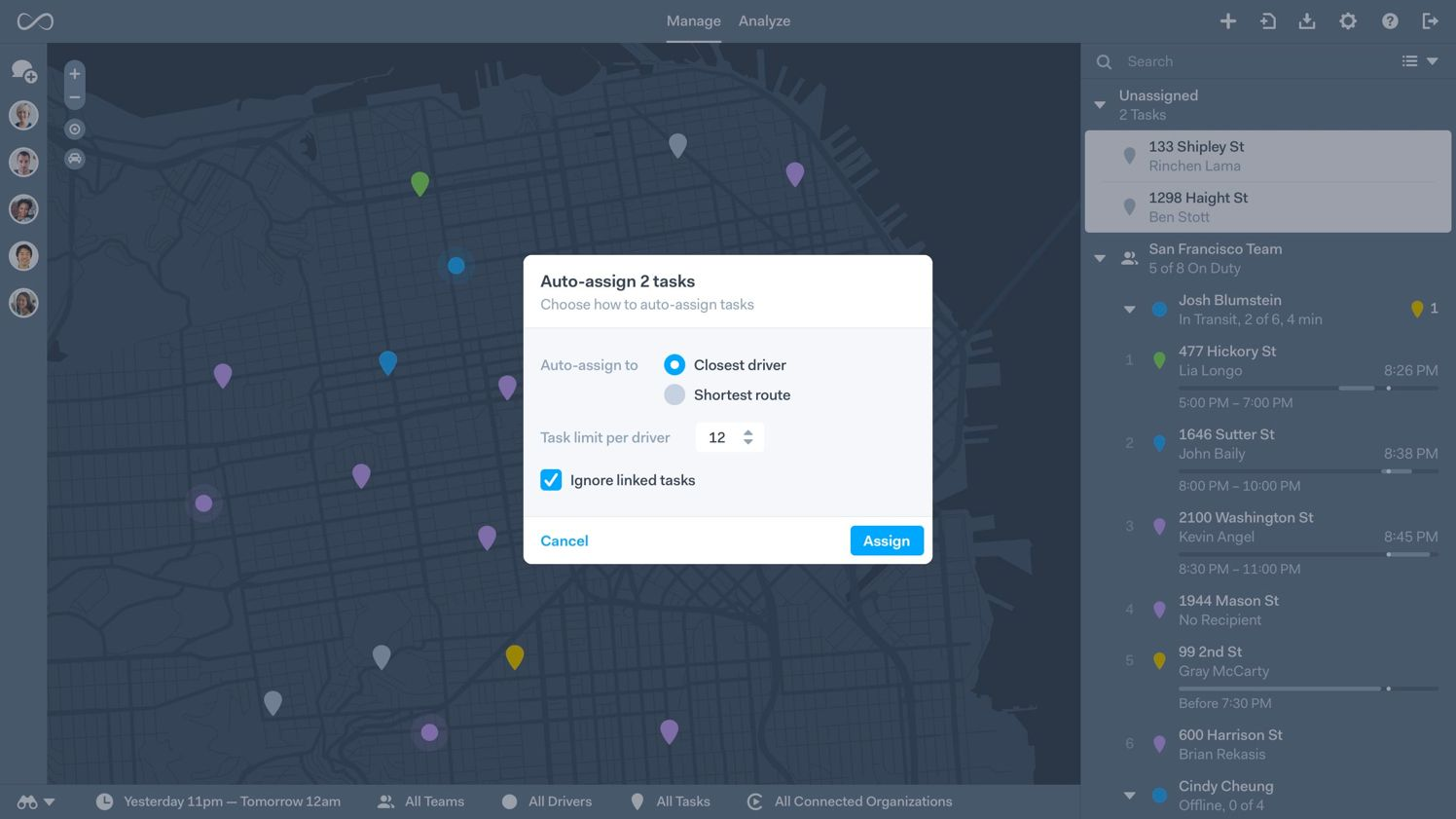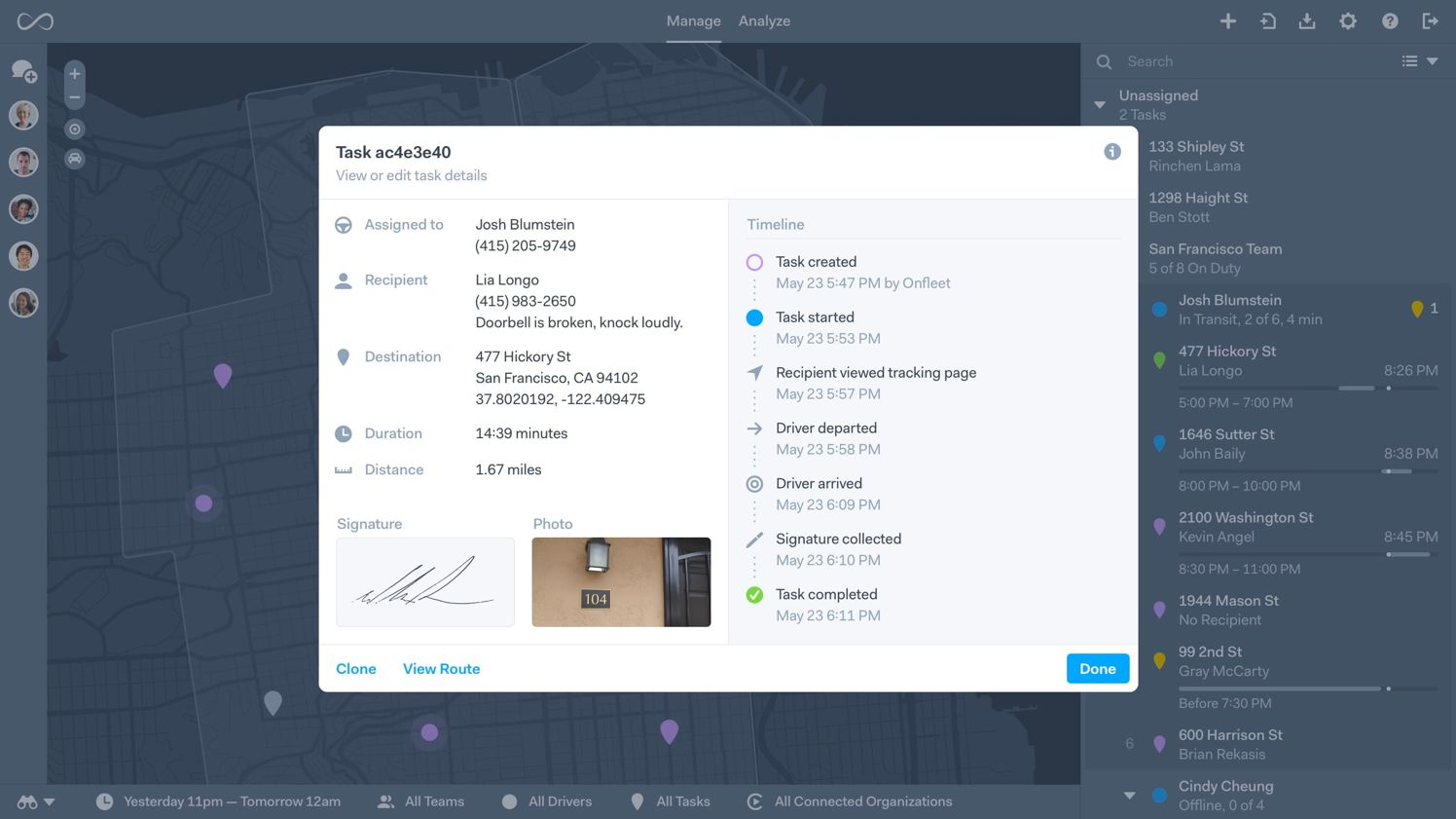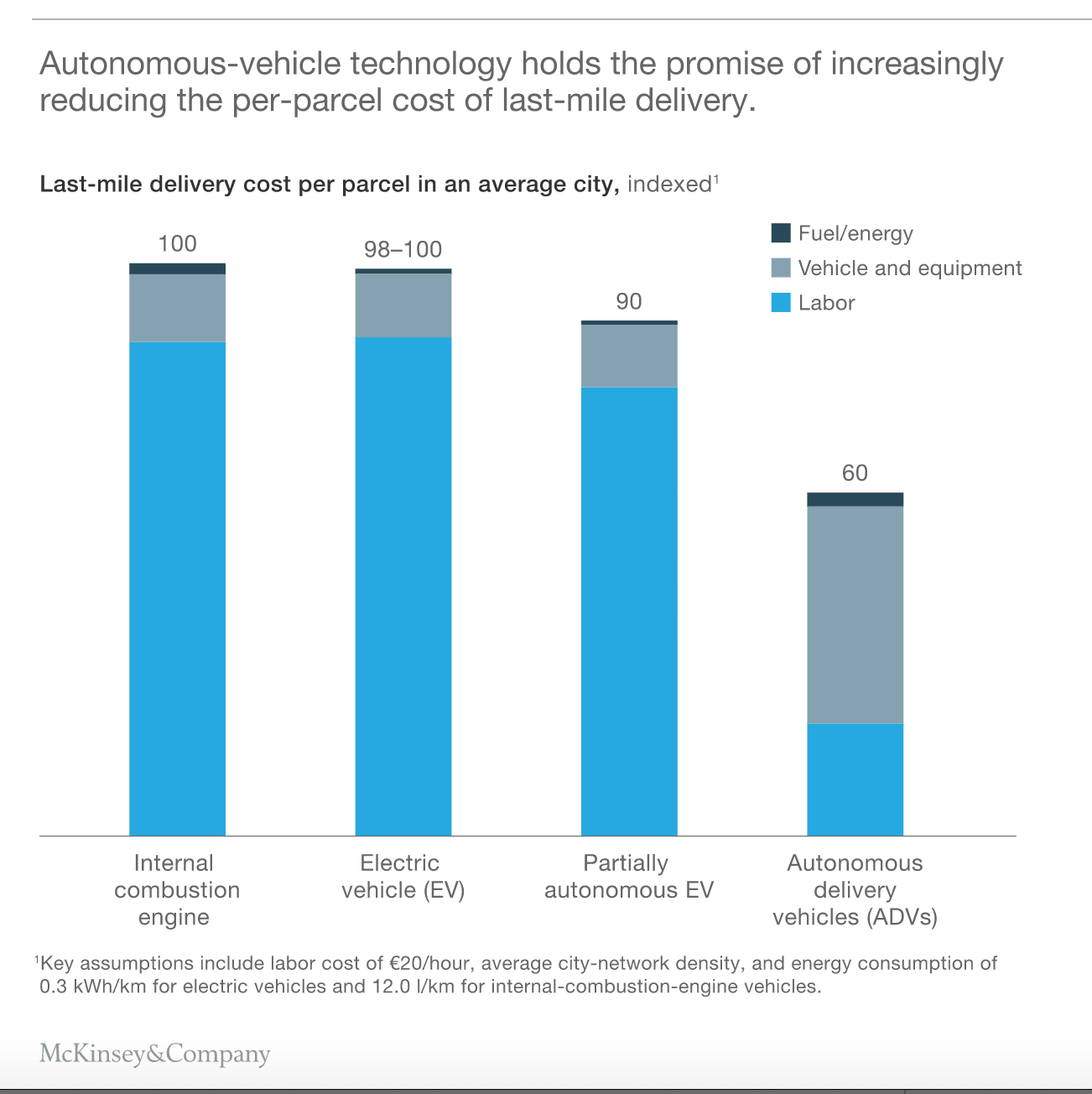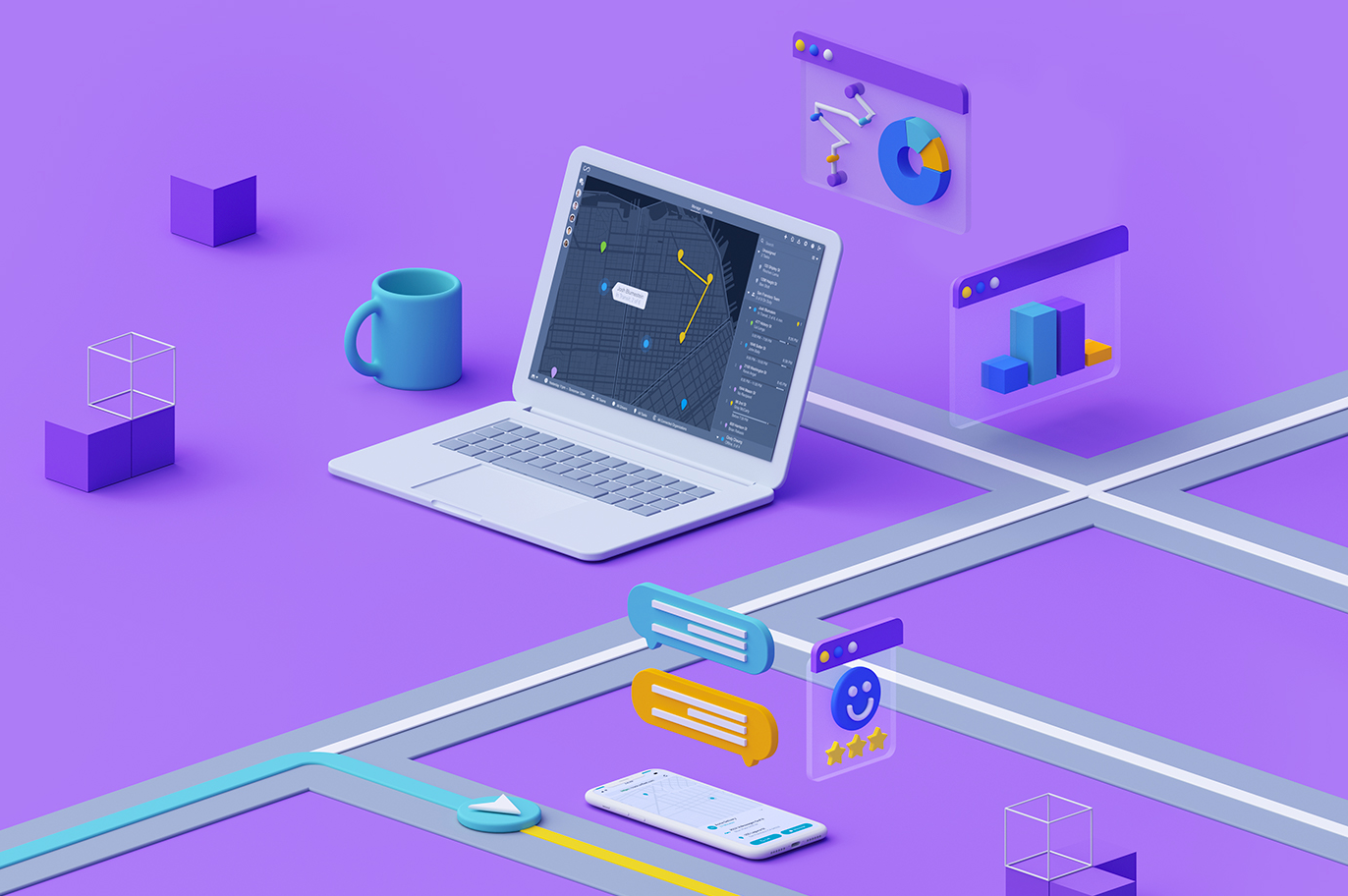
The demand for last mile technology will continue to grow.
Once a consumer clicks “Purchase,” say for groceries, a meal, or a new pair of sneakers, the action sets in motion what is called the Last mile delivery process.
Although it’s technically the shortest distance in a product’s journey, it’s usually the most expensive, often accounting for 53% of the total cost of delivery.
Companies that view delivery as an important channel are now looking for technology to make the last mile more efficient, cut costs, and improve profitability.

What is last mile technology?
Last mile technology is a term that describes a range of technologies that together streamline logistics operations, reduce costs, and improve the customer experience during the final leg in the delivery process.
The “last mile” begins the moment an order arrives at the transportation hub and ends when the package reaches the end-consumer. Businesses should aim to make it as fast and painless as possible—both to meet customers’ demand for fast shipping times and to avoid incurring unnecessary costs during the most expensive part of the delivery process.
While last mile technology includes everything from autonomous robots, drones, and trucks to big data analytics, sensors, and the blockchain, all share the same goal: to eliminating the friction points that cause delays and waste money along that all important final stretch in the delivery process.
How current technologies are shaping last mile delivery
New technologies have caused a major shift in buyer expectation and purchasing behavior. Consumers now expect free and fast delivery.
For example:
- Amazon taught us to expect ease of ordering, security, and fast delivery.
- Rideshare apps like Uber and Lyft trained us to expect 3D maps, ETAs, and two-way communications.
- Restaurant delivery apps like DoorDash, UberEats, and Grubhub ensured our delivery process would be visual, fluid, and fast.
These technology trends have caused consumers and businesses across a range of industries—groceries, prescription medication, prepared meals, alcohol, retail goods, and more—to reevaluate their entire delivery operation.
The COVID-19 pandemic has also had a massive impact on the demand for last mile technology. In fact, last-mile delivery has become critical to survival for many businesses that once viewed it as a “nice-to-have” distribution channel.
Today, bringing orders right up to a customer’s front doorstep is the only way certain businesses, retailers, restaurants and others, can remain competitive and satisfy demand.
The convergence of these trends has created challenges for many businesses, but the ones that use technology to adapt will be able streamline operations, set themselves apart from the competition, and capture more market share.
How Last Mile Technology Can Help Your Business
In this section, we’ll walk through some of the practical applications of last mile technology, and discuss how it can help streamline your delivery operation.
Use route optimization to cut delivery times
Route optimization involves plotting the fastest route for drivers to get any number of packages from a transportation hub to each of their final destinations.
This doesn't necessarily mean finding the shortest route. It means finding the most efficient route. This requires a business to factor in many variables, including:
- Delivery time windows
- Vehicle load capacity (weight and/or volume)
- Driver schedule
- Driver proximity and/or hub location
- Traffic congestion
- Accidents on the roads
- Location of stops
- Parking availability
- Start and end times and points for drivers
Managing all of these moving pieces would be onerous, if not impossible, without the help of last mile technology that automatically factors in time, location, traffic, and vehicle capacity to recommend the most efficient delivery routes for drivers.

Improves order accuracy and timeliness
Last mile technology can be used to improve order accuracy and timeliness.
Ensuring fast delivery begins the moment an order is placed. Rapid fulfillment and driver assignments play a major role in preparing orders for quick distribution.
Further, auto-dispatching can be used to reduce service time and cut labor costs. Managers can set rules that automatically assign delivery drivers to orders, in real-time, based on planned routes, GPS, driver locations and recipient addresses.

Increases visibility for drivers and customers
As e-commerce and food delivery continue to grow, exacerbated by COVID, companies can no longer ignore the impact an efficient delivery process has as a differentiator.
Last mile technology such as real-time location tracking and integrated communication capabilities are working to bridge the divide between drivers and customers and as a result, improve the customer experience.
Automatic status updates keep customers in the loop via SMS alerts and real-time driver tracking, so they can make sure someone is around to receive the package, reducing instances of damage or theft when packages are left on the doorstep for hours unattended.
Some delivery apps alert drivers when recipients are available to accept and sign for certain deliveries. Or, if they’re not home, drivers may be given the option to drop the package at an alternative collection point.
Visibility benefits the delivery company, as well, offering cost-savings and greater control over all of the factors that contribute to whether the customer experience is positive or negative.
For example, drivers make fewer return trips when customers can reschedule deliveries or receive notifications when the order is on the way, eliminating friction on the consumer side and reducing labor and fuel costs associated with repeat delivery attempts.
Improves transparency
In an industry study, 56% of consumers demanded greater transparency in the delivery process:

Delivery apps and improved location tracking capabilities improve transparency.
Location tracking technology allows fleet owners to see what’s happening at each stage in the delivery process.
That visibility allows companies to identify issues as they happen and course-correct before they escalate--whether there’s a major accident somewhere along the route that could cause delays or a customer complaint.
Customer feedback capture provides a channel for reporting issues, allowing companies to offer a resolution within minutes.
More companies are embracing proof of delivery documentation, be it a time-stamped photo or copy of the recipient’s signature, to confirm when an order has arrived at its final destination.

Delivery confirmation has become increasingly important amid the global pandemic, as delivery services like Uber Eats and Instacart have moved to contactless orders. Drivers can drop off the order, snap a photo, and automatically send an alert to the customer when the order is complete.
Measures efficiency and accountability
Access to real-time, granular data is unlocking significant value for business leaders in the logistics industry. Predictive analytics capabilities enable companies to identify and act on opportunities to improve.
Within Onfleet’s analytics dashboard, business leaders can measure efficiency and their ability to meet consumer expectations. They can review driver analytics and key operational metrics such as on-time rates, distance traveled, number of successful deliveries and consumer feedback scores - which can be used to identify weaknesses and opportunities in the last mile delivery process.

How technology will shape the future of last mile delivery
Last mile technology is evolving at a rapid pace—reshaping the delivery experience into something more flexible, efficient, and most importantly—able to adapt to changing customer needs and rising expectations.
Below, we’ve outlined some of the technologies projected to shape the delivery landscape over the next decade.

Electric vehicles (EVs)
According to McKinsey, electric vehicles (EVs) represent the first wave in transforming last mile delivery. Cities are increasingly tightening regulations on vehicle emissions, while at the same time, EV technology has become widely available, at least at the consumer-level.
As a last mile solution, EVs present a cost-effective, convenient option, and could soon become a requirement for meeting regulatory compliance standards.
The challenge is, in order for EVs to become a viable delivery option, drivers need reliable access to charging points to “fuel up.” While certain urban centers have plenty of charging points in place already, others still lack the infrastructure to support this sort of initiative.

Autonomous delivery vehicles (ADVs) and drones
McKinsey estimates that autonomous vehicles and drones will deliver 78% of items in the future, with traditional delivery accounting for only 20%.
While driverless delivery sounds like the stuff of science fiction, we’re right on the verge of seeing drones and autonomous delivery vehicles (ADVs) become a reality.
Long-term, ADVs will likely operate without human drivers, a change that will dramatically cut down labor costs, which as it stands, are responsible for about 60% of the total cost of delivery.
Accenture’s Andre Pharand captures the promise of autonomous vehicles in a quote featured in Supply Chain Dive:
“If parcels can be delivered by autonomous vehicles or drones, that will change the game considerably. The highest cost in delivery is labor, which accounts for 60% of the cost. Deliveries are currently limited by labor cost, availability, and shifts. Robotic delivery could be done 24 hours a day.”
While we can’t say for sure when ADVs will hit the mainstream, they’re already hitting the road.
For example, UPS has been using ADVs to deliver cargo for over a year through a partnership with TuSimple.
In December 2019, Plus.ai successfully completed a Level 4 cross-country run with a fully-loaded trailer of perishable cargo in tow. The truck was outfitted with an autonomous driving system that uses sensors, visual algorithms and simultaneous localization and mapping, or SLAM technologies.
In addition to tracking the truck’s location and performance, Plus.ai was able to monitor and control the refrigerated trailer--allowing them to maintain food compliance standards remotely.
Most recently, Waymo began testing its heavy-duty autonomous trucks in Texas, for now, loading them with weights, rather than customer orders.
According to that same McKinsey report, ADVs are likely to alter the competitive landscape significantly, providing customers with greater control and convenience, at a significantly lower rate than EVs and SADVs.

Drones offer another opportunity to provide cost-effective, fast delivery to consumers in remote locations. The big challenge here is, the murky regulatory environment.
Amazon announced plans for its drone delivery program in 2013 and has been experimenting with the technology in rural areas since 2016. Yet, they finally obtained FAA approval in August 2020.
The e-commerce giant is gearing up for the launch of Prime Air, which will deliver packages up to five pounds in 30 minutes or less in select areas.
Following Amazon’s announcement, Walmart announced it was expanding its partnership with Flytrex and began testing grocery delivery drones as part of a pilot program.

Robot deliveries
Delivery robots offer autonomous delivery on a smaller scale.
Eventually, we can expect to see robots dropping packages on consumers’ doorsteps, though companies are still testing solutions.
Amazon has been developing the Amazon Scout—a fully-electric autonomous delivery robot. As it stands, teams in Cambridge and Seattle are developing software that enables the Scout to navigate around pedestrians, pets, and other neighborhood obstacles.
We’re also starting to see some adoption in the food delivery space.
Yelp-Eat24 began testing robots a few years ago in San Francisco, sending them out under human supervision. More recently, we’re seeing an influx in autonomous robot pilot projects due to the current crisis.
Starship Technologies has partnered with Aramark to bring robot delivery to hundreds of US college campuses, currently struggling to practice social distancing and keep COVID cases at a minimum.
The autonomous bots offer on-demand delivery to students and faculty from various campus eateries. McKinsey predicted that robots were 10+ years away from widespread adoption due to high costs and the fact that the robots need to be trained to respond to a wide range of situations they might encounter on their route.
In controlled settings like a college campus or an office building, robot delivery is becoming a reality. However, large scale initiatives like what Amazon and FedEx are doing is a different story.

Autonomous picking
Improving last mile delivery begins in the warehouse with packing and picking.
RFID sensors and scanning technologies are already being used to quickly identify and prepare items for shipment, though robots are increasingly playing a larger role in the fulfillment process.
Sensor-enabled robots carry totes to pick locations, where they’ll meet human workers and help them find the items customers ordered and place them in the totes. The bots then scan products to ensure that the items in the tote match the order, and from there, prepare them for shipment. The benefit here is, autonomous picking reduces costs associated with human labor and picking errors.

How are you going to use technology to improve last mile delivery?
Advances in last mile technology will reduce costs and drive efficiencies for carriers and improve the customer experience. This provides an opportunity to gain a competitive advantage in a market that is rapidly changing. All of these technologies are being developed and harnessed by businesses. The next steps are how to scale and share them with a broad range of industries and practices.
Related Reads You Can't Miss:
- How Delivery Technology is Reshaping the Construction Industry
- How Grocers Can Leverage Technology to Make Delivery a Competitive Advantage
- How Super Bowl 50 Impacted the On-Demand Economy
- The 4/20 Impact on the On-Demand Economy [INFOGRAPHIC]
